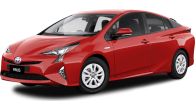FEW cars have been as complicated or controversial as this current-generation Mazda3.
Launched in early 2019, it would have garnered stellar reviews if Mazda hadn’t decided to ditch the base Neo and kick things off instead with the mid-spec Pure. Consequently, the price of entry jumped by $4500, with predictably many buyers feeling abandoned by the brand. Sales have since declined, but that’s the general small-car trend anyway as the SUV’s stranglehold tightens.
Some enthusiasts weren’t too keen on the rear suspension’s switch from a sophisticated multi-link to a simple torsion beam either, claiming it didn’t align with Mazda’s sporting reputation.
Then the long-awaited, much vaunted Skyactiv-X models arrived in mid-2020 – a compression-ignition supercharged eco model promising diesel-like petrol economy without the noxious fumes and with improved performance and refinement to boot. Years in the making, the hype had perhaps been overblown because what eventuated wasn’t a Prius-rivalling yet GTI-like saviour, but something altogether… more nuanced.
Now, as the dust settles, we take another look at the Skyactiv-X-equipped 3 (X20) in flagship Astina auto guise, to see if the mainstream small car has evolved as much as Mazda has us hoping.
And, more importantly, whether the Mazda3 can cut it as a premium proposition.
Mazda 3 2021: X20 Astina M Hybrid
| Engine Type | Inline 4, 2.0L |
|---|---|
| Fuel Type | Unleaded Petrol/Electric |
| Fuel Efficiency | 5.5L/100km (combined) |
| Seating | 5 |
| Price From | $32,340 - $38,500 |
| Safety Rating |
|
Does it represent good value for the price? What features does it come with?
The X20 Astina auto starts from $41,590 before on-road costs.
That’s around $4000 more than the vaunted new Volkswagen Golf R-Line ($37,450), $5000 more than the spirited Hyundai i30 N-Line Premium ($36,220), $7000 more than the frugal Toyota Corolla ZR Hybrid ($34,695), $8000 more than the roomy Kia Cerato GT ($33,690) and nearly $10K more than the dynamic Ford Focus ST-Line.
Or, if you like, the Mazda is $6000 under the now-front-drive BMW 118i, $5000 less than the ultra-cool Mini Cooper S Clubman and $3500 cheaper than the slick Mercedes-Benz A180.
It’s in the no-man’s land of beyond mainstream and aspirational, and about three quarters of the way to premium. In fact, a runout (old-shape) MY20 Audi A3 Sportback in mid-range 35TFSI S Sportback spec is nearly a grand cheaper while the X20 Astina is lineball with the geriatric Lexus CT200 Luxury.
So, how does the Mazda respond to such observations?
Firstly, being the flagship grade, the X20 Astina’s features list is extensive.
The full suite of safety gear includes seven airbags, front and rear autonomous emergency braking with pedestrian and cycle detection, Blind Spot Monitoring, Lane Departure Warning, Lane-keep Assist, driver monitor, Forward Obstruction Warning, Rear and Front Cross Traffic Alert, Secondary Collision Reduction (that automatically keeps the brakes applied to stop further impacts), auto high beam control for the adaptive headlights, breakaway pedals, adaptive cruise control with full stop/go functionality and cruising/traffic support, parking sensors front/rear, 360-degree round-view monitor, reverse camera, traffic sign recognition and tyre-pressure monitors.
On the luxury side, there’s leather upholstery or leather-looking material everywhere including over the dashboard, heated front seats, a powered driver’s seat with position memory, heated leather steering wheel, windscreen-reflected full-colour head-up display, satellite navigation, auto tilt/folding/heated/dimming mirrors, sunroof, dual-zone climate control, Apple CarPlay/Android Auto, Bose premium audio with amplifier and 12 speakers, Bluetooth phone/audio connectivity, digital radio, keyless entry/start and polished 18-inch alloys.

So why is the top Mazda3 so expensive?
Mazda argues that what the X20 offers that the others don’t is its unique SkyActiv X technology. Confusingly branded ‘hybrid’, it is in fact much like a normal 2.0-litre petrol engine with diesel-like compressed ignition that promises significantly reduced consumption; there’s no electric motor, just a belt-driven integrated starter generator (ISG) and a 24-volt lithium-ion battery that captures otherwise spent energy during deceleration to power the ISG; basically it’s a hybrid that’s milder than a gay courting scene modified for viewing on a Middle Eastern airliner.
The thing is, Skyactiv-X is a hefty $3000 option over the conventionally-powered G25 Astina, which uses a 139kW/252Nm 2.5-litre four-cylinder petrol engine that is both more powerful and torquier than our X20 Astina’s 132kW/224Nm 2.0-litre SkyActiv X unit. Where you might find a benefit is in the latter’s official 5.5L/100km combined fuel consumption average, against the former’s 6.6L/100km. You’d hope so anyway, as a way of making a return on investment.
Note that its most powerful aforementioned rivals (rorty i30 N-Line and Cerato GT) deliver 150kW while the most frugal one (sluggish Corolla ZR Hybrid) returns just 4.2L/100km.
Except for the pesky (and woefully underrated) Focus and its 132kW output and 6.4L/100km economy, on numbers alone, the X20 Astina’s efficiency promises look… promising.
Is there anything interesting about its design?
Here’s where the Mazda3 really starts making up ground.
Love it or hate it, the BP-series’ design is a statement of huge ambition, melding a svelte coupe-like silhouette with a broad stance, sinewy surfacing and startlingly pared-back detailing.
This is the brand’s boldest-looking small car since the 1993-1998 BA Astina (Lantis/323F/Allegro/Artis elsewhere) – a five-door coupe styled by an ex-Porsche designer involved with the 924, 944 and 928. Disclosure time: your author bought a ’96 1.8 manual recently and is in love with its styling.
Anyway… with hints of those as well as the epochal Alfa Romeo Alfasud, the latest Mazda3 looks like a million dollars – handy for a company wanting to move up in society – and so deserves to go down in history as one of Mazda’s bravest moves.
From a functionality point of view however…
How practical is the space inside?
Here’s the deal. Mazda3 sales have been steadily declining globally, as with most small cars – because people no longer want low-riding hatchbacks when high-riding crossovers like the Nissan Qashqai cost barely anymore yet allow their drivers to lord it over others.
So, it makes sense that Mazda decided to make the newly-created CX-30 as the practical, jacked-up version of the 3, while the hatch became the sleek and interesting coupe-like alternative that said something about its driver. Mazda hasn’t said actually said as such, but it’s patently clear that this is a painstaking, design-led exercise.

Coupe-like. That means a comparatively low roofline, making entry/egress a stoop-forward affair. Actually, though, the 3’s not too bad, and is still quite painless to move in/out of.
But not as painless as the smooth, soothing and stylish shapes of the dashboard. Flowing, integrated and minimalist in appearance, it’s as strong a design statement as the exterior. It’s also proudly Japanese in flavour, texture and intricate quality. As we’ve observed in the recent past, luxury European brands cannot achieve this level of aesthetics and craftspersonship at the Mazda’s price point. Just look at a base A3, A200 or 118i and their Les Mis levels of austerity. The Astina continues to close the gap.
Just drilling into some of the 3’s interior details, the driving position is first class.
Thoughtful ergonomics, plenty of adjustability from the steering column and seat, arguably the greatest steering wheel in the business today due to its large, thin rim and classical three-spoke visage that’s just a delight to behold, and perhaps the most beautiful analogue-like digital instrument dials at any price point. Crisp, clear and pared back, you might imagine if Saab was still around this is what you might find in.

As we’ve mentioned in other reviews, the dials and surrounding air vents are reminiscent of the latter 944/968-era Porsche equivalents in their presentation. Gorgeous. So are the head-up’s colour data display, nifty little paddle shifters, stubby little auto gear lever (with the ‘+’ a pull-back action and the ‘–’ downshift a light push forward) and oiled tilt/telescopic column adjustment.
We’re talking about a range that starts from $26K here, folks!
Our $41K Astina’s red faux-stitched vinyl dash covering further provides a classy contrast to the smooth plastics and metal finishes peppering the cabin.
Keeping in mind this is a traditionally proportioned two-box C-segment hatchback, there’s sufficient space for four people, and a fifth at a squeeze. The front seats are well padded in the cushion, supportive in the backrest and fine even after hours behind the wheel. We must mention, too, that having a passenger seat-height adjuster is great. There’s ample space to stretch too. Storage is excellent, as is ventilation and the way everything is put together, and the overall sense and ambience is of premiumnness.

Much the same applies in the back, with a split/fold rear backrest that offers a comfy angle, while the cushion is also well padded. Knee room is fair, but headroom isn’t great if you’re tall, as the falling ceiling line reveals. Most amenities you’d expect are present back there, such as face-level air vents, access to USB charge points (located in the big bin between the front passengers), a folding centre armrest, cupholders and useful door pockets.

However, a few design-related flaws may irritate some people. Like the ultra-thick door pillar that limits the size of the back-door windows, creating elephantine blind spots for some passengers. It’s a bit gloomy back there as a result, and that’s not helped by some of the lower-lying plastic trim that are fine in a $30K hatch but seem a little cheap compared to an A3’s.
And then there’s the multimedia technology, which hasn’t been keeping pace with the latest offerings from other brands. Where is the wireless phone charger, WIFI hotspot and rear-seat USB ports? Passengers must lean forward and fumble with one of the two outlets sited up front, with ungainly cords getting in everybody’s way. And the sunken 8.8-inch widescreen is not big enough nowadays and already looks and feels dated in its operation.

Finally, there is the meagre cargo capacity. At just 295 litres, it might embarrass the Corolla hatchback’s 217L item, but it is roundly beaten by almost every other competitor. The aperture to put stuff in is large enough, with a long and wide flat floor that of course is extended when the 60/40 backrests are dropped, but the rake of the hatch and height of the load area eat away at those precious litres. The spare is a space-saver item underneath.
Overall, then, the interior is an aesthetic success and the limitations are there for everybody to see the moment they first climb inside – poor rear-seat vision, multimedia-related shortcomings, low roof line when exiting the back and that smallish boot.

Yet the Astina’s richness inside is obvious. Nobody will sit here and think they’re in a mid-ranking Corolla competitor. Not until they see the Mazda badge anyway.
What are the key stats for the engine and transmission?
The X20 Astina is powered by a 1998cc 2.0-litre supercharged twin-cam four-cylinder petrol engine, delivering 132kW of power at 6000rpm and 224Nm of torque at 3000rpm.
It drives the front wheels via a six-speed torque-converter automatic transmission, with an 8.6 second time to 100km/h, on the way to a 216km/h top speed (in European-spec models). There is also a six-speed manual available, though not the all-wheel drive offered elsewhere.
The combustion process is what’s different to the regular 2.0-litre engine on which the Skyactiv-X is based upon.

Dubbed Spark Controlled Compression Ignition (SPCCI), it means the engine switches between normal spark ignition to diesel-like compression ignition combustion, by using a spark to trigger both types of combustion at different times during the fuel injection process – lean during the intake stroke and atomised fuel around the spark plug during the compression stroke. The Rootes-style supercharger, meanwhile, is there to boost low-speed response, not to reel in Honda Civic Type Rs.
There’s also the integrated starter generator and 24V lithium-ion battery – the latter stores regenerative brake energy to power the former – to help save fuel.
How much fuel does it consume?
OK, so far, so good. But does the X20 Astina deliver diesel-like fuel economy?
The answer is… sort of. We drove ours in searing summer heat, air-con on, and always more than one person driving, mostly around the city and suburbs, but also out on the open road, and with some very spirited performance testing.
Mazda’s tests show the X20 averaging an official figure of 5.5 litres per 100km, for a carbon dioxide emissions average of 135g/km, while we managed a pretty good 7.9L/100km at the pump. Past tests with diesels produced similar numbers, when the regular petrol equivalents were in the high 8s and up. We’d consider this a qualified success given the demanding conditions it was subjected to, but not the panacea some of the company’s hype would have us believe.
Note, too that the X20 must drink 95RON premium unleaded, though the cheapest petrol around at the moment – 94 RON E10 ethanol – is fine too.
Fitted with a 51-litre tank, over 925km between refills is possible.
Warranty & Safety Rating
What safety equipment is fitted? What safety rating?
Among the safety systems standard in the Astina are AEB (with a working range of 10km/h to 80km/h) with pedestrian and cycle detection, while the Forward Collision Warning operates from 40km/h to 200km/h.
You’ll also find Blind Spot Monitoring, Lane Departure Warning, Lane-keep Assist, driver monitor, Forward Obstruction Warning, Rear and Front Cross Traffic Alert, Secondary Collision Reduction (that automatically keeps the brakes applied to stop further impacts), auto high beam control for the adaptive headlights, breakaway pedals, adaptive cruise control with full stop/go functionality and cruising/traffic support, parking sensors front/rear, 360-degree round-view monitor, reverse camera, traffic sign recognition and tyre-pressure monitors.
Seven airbags are fitted – front, side, curtain and a driver’s knee item – as are anti-lock brakes with Electronic Brake-force Distribution, Emergency Brake Assist, stability control, traction control, hill-start assist are also fitted, seat-belt pretensioners, and two rear-seat ISOFIX points as well as three top tethers for straps.
Tested in 2019, the current Mazda3 range achieves a five-star ANCAP crash-test rating.
What does it cost to own? What warranty is offered?
Mazda offers a five-year/unlimited kilometre warranty as well as roadside assistance on all Mazda3s, as well as capped-price servicing, scheduled at every 12-month or 10,000km intervals.

Published online, the prices for the X20 vary between $344 and $374 annually, and are listed for up to 16 years/160,000km. Note, however, that additional scheduled maintenance items that must be replaced or attended to will increase that price as the vehicle ages.
What's it like to drive around town?
Any doubts surrounding the latest Mazda3’s ability to compete with upmarket European alternatives should by now be fading, given the Astina’s design, engineering and safety.
For the most part, the good news keeps on coming on the road as well – but a level of expectation management is required if you’re expecting a supercharged hot-hatch performer, because this simply is not that sort of car.
Mazda makes a lot of noise about how much quieter and more refined its vehicles are even compared to the last generation released in the mid-2010s. This is no more obvious than in the Mazda3, with an interior that is as quiet and as isolating as the best of them. We’re talking Golf and Lexus, if you need reminding.
However, this may cause some disappointments in other areas, because the X20 Astina is almost shy about the way it delivers its substantial performance.
The powertrain is surprisingly smooth and hushed for a Mazda engine that thrives on revolutions to perform, with an effortless flow to the way the car sets off and accelerates. In fact, the X20 launches off the mark with quite a bit of urge – and without lag or hesitation from the eager transmission – building up speed quickly.
What is missing is the turbo wallop of, say, a Golf TSI or Focus EcoBoost engine. Instead, there’s a very definite groundswell of performance. Like its non-X siblings, the 3’s 2.0-litre atmo engine relies on revs for power, but in the X20, usefully more torque seems to come on stream at the same time, so once on the move, throttle response is really willing and able. Certainly, stronger than that 0-100km/h time of 8.6s suggests. And you don’t need to visit the red line and endure the regular 2.0-litre’s metallic howl as a result. Get used to squeezing the accelerator in the mid ranges, and you’ll realise just how fast this can be.
Mazda has already released an uprated X20 specification in Japan, raising the power and torque outputs to 140kW and 240Nm. If punchier and more dramatic performance is the upshot, then we’d welcome that. The Skyactiv-X’s charms blossom with familiarity.
If the Astina’s power delivery is nuanced, its handling is delicate, with steering that’s light yet measured and involving, providing accurate and flowing roadholding that remains consistent and controllable even as speeds rise. Bumps don’t faze the suspension, which just sticks gamely to the road. The Mazda walks a fine line between being luxurious and feeling sporty, with an unruffled agility that’s very satisfying for keen drivers to explore.
Earlier, we said the cabin is remarkably quiet – and not just by Mazda standards. That MacPherson-style front/torsion beam rear end might seem simple on paper, but it manages to provide a civilised and sophisticated ride. Some of the bigger bumps reveal a slight firmness to the chassis tune, but the car isn’t crashy or loud around town, simply gliding along with confidence and ease.
Where the Mazda3 loses some of its edge is in its poor rear vision, which can make parking it in tight spots a little harder than it needs to be. There aren’t the clear views out of most urban SUVs, making the latter’s ascension in the sales charts understandable.
That’s the price of that coupe-like silhouette.
Verdict
Granted. The Mazda3 X20 Astina is an expensive mainstream-branded hatchback from Japan. This is not your aunt’s BJ 323 Protégé Shades.
Still, as with all the current-series BP 3s, the fundamentals are spot on – evocative design inside and out, obsessive detailing, superb quality, progressive engineering and delightful dynamics – in a safe, practical, reliable and brilliantly efficient package to boot.
We understand that, for some people, the X20 Astina strong but silent-type personality may be too understated. But the fact remains that it is a graceful yet forceful and fast grand touring hatchback when called upon, with all the athleticism and sophistication that implies.
Mazda’s hype around the Skyactiv-X powertrain promised Wonder Woman but the Diana Prince we have instead still makes it a marvel. Maybe you should hold on a little longer and wait for the more powerful model expected imminently. Either way, you’re in for something special. The 3’s controversy rages on.
Pricing Guides









































































.jpg)

.jpg)
.jpg)



.jpg)

Comments